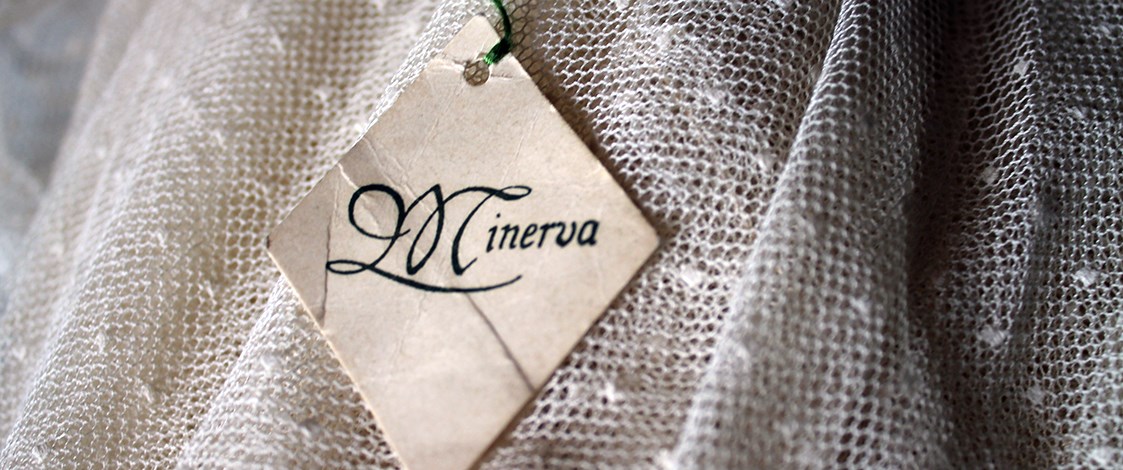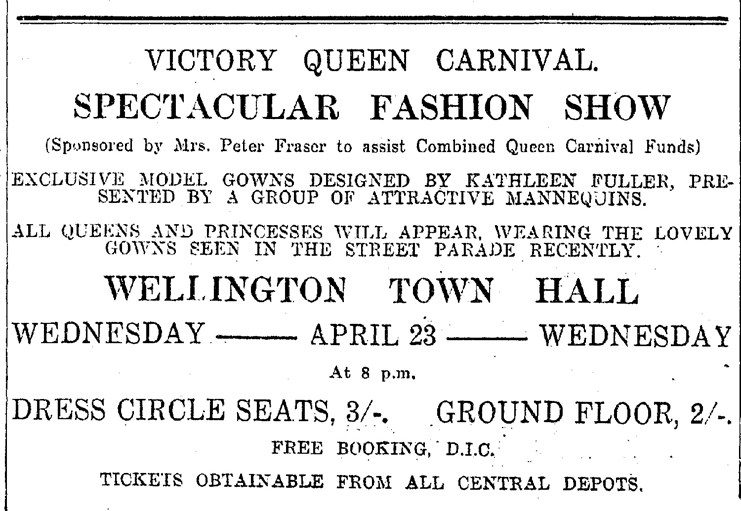Stories
Kathleen Fuller & Minerva Frocks
1892-1975

Since the evolution of the dressmaking pattern in the late 19th century, women (and men) have made their own clothes. For a garment as special as a wedding dress, however, many women would seek the assistance of a professional dressmaker. Dressmakers were plentiful in every New Zealand town and city until the 1970s.
For the first half of the 20th century, those involved in the making of fashion were described as 'dressmakers' and 'costumiers' in the New Zealand’s urban and rural trade directories – the early equivalent of today’s telephone books. The term 'dress designer' was rarely used in New Zealand until the 1950s, and then mostly to describe London or Parisian designers such as Paul Poiret.
However 31-year-old Kathleen Fuller didn’t hesitate to label herself as a designer when she advertised her new business, Minerva Frocks, in 1923. "For Original and Artistic Frocks, Costumes, Blouses, Lingerie etc, visit the Minerva Salon … Designer, Kathleen Fuller, late John Court Ltd., Auckland."

Ad for 'Designer, Kathleen Fuller' in the Christchurch Press, 29 June 1923.
Kathleen had only recently moved to Christchurch from Auckland, where she held the position 'head of a department' at John Courts Ltd. The Queen Street store advertised itself as 'Auckland’s Leading Drapers' and sold not only fabrics but fashionable clothing, some of which was manufactured onsite in the JCL Workroom.
Photo of Kathleen Fuller. Image from Alexander Turnbull Library, PAColl-6411-15.
It is very possible that the department 'headed' by Kathleen Fuller was Fashion, or 'Costume' as it was often referred to in the 1920s and earlier. John Court’s did sell model gowns - which in the 1920s referred to limited edition, if not exclusive, fashions, that were often fitted to individual customers in house. It is not a stretch to surmise that Kathleen might have had a hand in the design of these gowns.
By June 1923, Kathleen had left Auckland and opened her salon, Minerva. It was located in a building on the corner of Cashel and Manchester streets. There was a display window on the Cashel Street side of the building, and her salon and workrooms on the first floor.
Kathleen advertised her designs regularly in her local newspaper, the Press. She changed her advertisements about once a month unless special events, such as Race Week in August, called for more focused advertising.
Kathleen’s fashion radar was very much tuned to international trends as a 1924 advertisement for 'Model Frocks brocaded in Tutankhamen design' attests. Following Howard Carter’s famous discovery in 1922, the fashion and design world succumbed to Egyptomania. She offered a broad range of outfits during the 1920s: day, afternoon, semi-evening and evening frocks, beach and tennis dresses, blouses, coats, coat-frocks and bridal.
She was also very up-to-date with the types of textiles that she offered her customers - crepe de chine, Japanese 'Fuji' silk, marocain (a ribbed crepe fabric) and shot taffeta. In February 1925 she advertised 'something quite new' for her evening frocks – they were made from 'specially imported robe lengths ... in Embossed Chemelle Georgette, Tinsel Damask Embossed, Chiffon Velvet, and Satin beaute.' Kathleen also offered a service of making up a customer’s own fabric in the latest designs.
On the last day of August 1924, the ignition of the contents of a small oil can resulted in a catastrophic fire that destroyed most of the garments and woollen cloth in the Canterbury Woollen Company’s showroom located adjacent to the Minerva Salon. Despite a newspaper report stating that the salon suffered considerable damage to much valuable stock, Kathleen assured her customers that many of her clothes were only 'slightly smoked'. With Race Week about to start, she was keen to rid herself of the tainted stock and offered genuine fire sale bargains for a week or two following the fire.

Kathleen advertised ‘genuine fire sale bargains’ after a neighbouring fire destroyed much of her salon.
Being insured (for £200) meant that Kathleen could completely renovate her salon and within the space of a month she was advertising again - "a charming range of spring goods".
The final advertisement for Minerva Salon appeared in the Press in mid-January 1928, and provided no public indication why the designer would soon close her business and move to Wellington. Six months later, Kathleen had secured premises in the Imperial Buildings in Wellington’s Dixon Street and was advertising for staff. There is no mention of a salon, so it is most likely that she wholesaled her garments to frock salons and department stores in Wellington, if not further afield.
Sometime in 1931 Kathleen moved her business to premises in the Levy Building on the corner of Manners and Taranaki Streets. She continued to present her garments publicly in the form of mannequin parades, sometimes in association with, or supporting another event. She was particularly active in her support of World War Two fundraising causes. One of the most prominent of these was the Mannequin Parade that Kathleen presented to raise funds as part of the Victory Queen Carnival.

Advertisement for the Victory Queen Carnival fashion show featuring gowns designed by Kathleen Fuller. Evening Post, 19 April, 1941.
Her designs were acknowledged in a description of the Victory Queen Carnival finale evening held at Wellington’s Town Hall in 1941. "To a musical accompaniment, mannequins displayed a wide variety of feminine wear, including daytime suits, afternoon and evening gowns, debutante, and mother and daughter styles, concluding with an attractive wedding group. These gowns, designed by Miss Kathleen Fuller, showed what can be produced here despite wartime conditions and import restrictions ... Mrs Walter Nash presented Miss Fuller to the audience and ... thanked all those who had organised or assisted in the success of the show."
Text by Angela Lassig. Kathleen Fuller's gowns were part of the 2017 exhibition 'Till Death Us Do Part', curated by Rose Jackson. Banner image of a Minerva Gowns label © Rose Jackson.
Published May 2019.